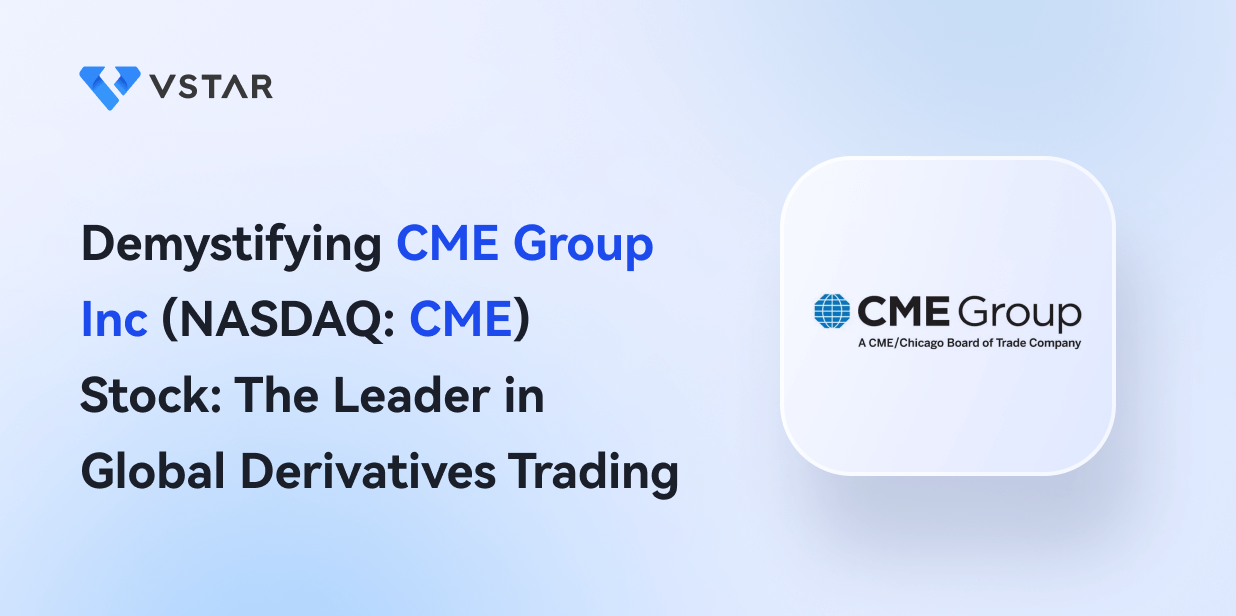CME Group has announced plans to expand options on WTI Crude Oil to include Monday and Wednesday expirations. Subject to regulatory approval, this initiative is expected to launch on July 31, 2023, increasing trading flexibility and providing more hedging opportunities, which should attract a broader range of market participants.
In addition, CME Group expanded its cryptocurrency options offering to include both standard and micro-sized bitcoin and ether contracts. This has increased versatility and given traders more control and opportunity in the dynamic cryptocurrency space. This, in turn, has increased CME Group's appeal in a rapidly growing sector.
All of the above are just recent developments that more than point to the fact that CME stock is a very viable investment opportunity for investors and traders. But before we take a closer look at CME stock and answer the questions, "Is CME stock a good long-term investment?" and "Is now a good time to buy CME stock?", let's take a quick look at an overview of CME Group Inc.
CME Group Inc's Overview
CME Group Inc. was founded in 1848 as the Chicago Butter and Egg Board before changing its name to the Chicago Mercantile Exchange (CME) in 1919. The company is headquartered in Chicago, Illinois, USA.
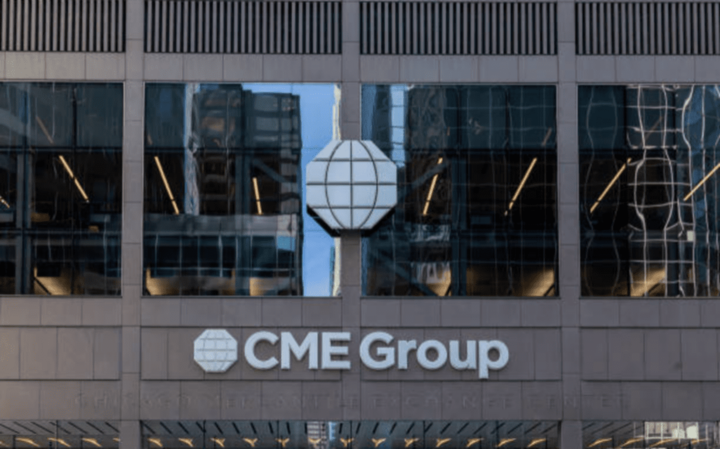
Credit: iStock
What is CME
CME Group Inc. operates as a multi-faceted organization, managing several major exchanges, including the Chicago Mercantile Exchange, the Chicago Board of Trade, the New York Mercantile Exchange and the Commodity Exchange. The company is currently led by CEO Terry Duffy, an industry veteran who joined the company in 1981 and rose through the ranks to his current leadership position.
Ownership of CME Group Inc. is divided among several major shareholders. Major shareholders include The Vanguard Group, Inc., JPMorgan Investment Management, Inc. and Capital Research & Management Co.
Throughout its long history, CME Group has achieved many milestones. Some of these include the following:
- The introduction of financial futures in 1972.
- The company became the first U.S. exchange to go public in 2002.
- In 2007, the Chicago Mercantile Exchange and the Chicago Board of Trade merged to form the CME Group.
- CME Group acquired NYMEX in 2008, allowing it to add energy and metals to its product offerings.
CME Group Inc's Business Model and Products/Services

Credit: iStock
CME Group Inc. is principally engaged in providing a platform for financial institutions, corporations and individual traders to trade futures contracts and derivatives. The Company generates revenue primarily through transaction fees on traded contracts, which vary based on the type of product and the volume of trades executed.
In addition, the Company generates revenue from market data services by selling real-time, historical and other market data to subscribers. This includes the provision of trading analytics, indices and other investment tools.
CME Group also generates revenue from access and communication fees, which are fees charged to members and non-members for connecting to its electronic trading platform. In addition, the Company generates revenue from clearing and transaction fees, which provide services to settle trades and mitigate risk.
Main Products and Services
CME Group offers a wide range of products across various asset classes. Its primary offerings include futures and options on futures trading in asset classes like agricultural commodities, energy, metals, interest rates, foreign exchange (FX), equities, and digital assets (cryptocurrencies).
One of its signature offerings is trading futures and options on the S&P 500 Index, widely considered the benchmark for the entire U.S. equity market. The company has also been a pioneer in the cryptocurrency space, introducing bitcoin futures in 2017 and ether futures more recently.
CME Group Inc. also provides various other services, including trade processing, risk management and market data services, to support the diverse needs of its global customer base.
CME Group Inc's Financials, Growth, and Valuation Metrics
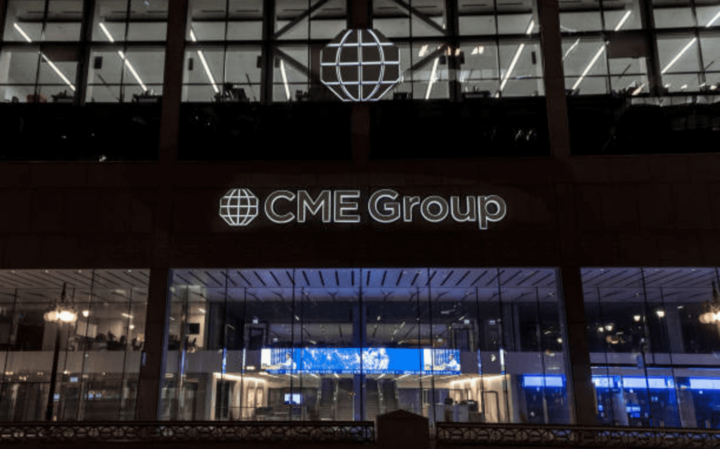
Credit: GettyImages
CME Group Inc has a market capitalization of USD 66.95 billion. For the first quarter ended March 31, 2023, CME Group reported operating income of $0.914 billion, reflecting a robust growth of 6.36% compared to the same period of the previous year. For the year ended March 31, 2023, the company's operating income was $3.071B, a significant increase of 10.48% compared to the previous year.
CME Group's revenue for the quarter ending March 31, 2023 was $1.442B, signifying a remarkable 7.05% growth from the previous year. Over the past five years, the company's revenue growth trajectory has been impressive, rising from $4.309B in 2018 to a solid $5.019B in 2022. As of March 31, 2023, CME Group's net income margin stood at a strong 55.99%, demonstrating the exceptional profitability of the company's operations.
Key Financial Ratios and Metrics

Credit: iStock
As of July 14, 2023, CME Group's P/E ratio is 22.10, while its main competitor, Nasdaq Inc, has a lower P/E ratio of 18.95. The higher P/E ratio could be interpreted as the market's higher expectations for CME Group's future growth.
Based on the most recent financial statements and stock price, the price-to-sales (P/S) ratio (TTM) for CME Group is currently 13.0875. In addition, CME Group's price-to-book (PB) ratio is 2.45. In comparison, its competitors have higher ratios, with Intercontinental Exchange Inc at 2.84 and Nasdaq Inc at 4.01. This suggests that CME stock may be undervalued relative to the market and the industry.
In terms of stock valuation, CME Group's stock is currently trading at $186.13, which is 3.91% below its calculated Fair Value price of $193.70. Thus, it is undervalued. It's important to note, however, that the stock is not severely undervalued given the relatively small 3.91% discount to the Fair Value price of $193.70.
CME Stock Performance Analysis

Credit: iStock
CME stock went public in 2002. It trades on the NASDAQ stock exchange under the ticker symbol "CME". The company is based in the United States, and therefore, its stock is traded in U.S. dollars.
Regular trading hours on the NASDAQ, where CME is listed, are from 9:30 a.m. to 4:00 p.m. Eastern Time. However, investors also have the opportunity to trade CME Group stock during the pre-market and after-market sessions. Pre-market trading hours are from 4:00 a.m. to 9:30 a.m. Eastern Time, while after-market trading hours are from 4:00 p.m. to 8:00 p.m. Eastern Time.
CME Group Stock Splits: CME stock has undergone two stock splits so far, with the first one taking place on July 6, 2012, and the second on July 23, 2012
CME Stock Dividends: CME stock currently yields a quarterly dividend amount of $1.10 and an annual dividend yield of 2.36%.
CME Stock Price Performance Since its IPO
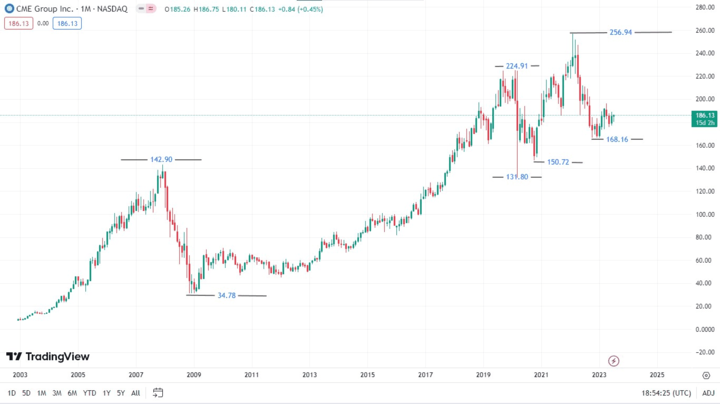
Since its IPO, CME stock gradually increased in price until it reached the 142.90 level. CME stock then dropped sharply to the 34.78 area, where it range-traded for some time before rallying and breaking through its previous high to a new high of 224.91. CME stock then briefly and sharply dropped to a low of 131.80, rallied briefly, and then settled at a low of 150.72.
After this, CME stock price increased in value again in a bullish run that saw it create a new all-time high at 256.94. CME stock price then dipped to create a higher low of 168.16 level. Currently, the CME stock price is around the 186.13 level.
Key Drivers of CME Stock Price
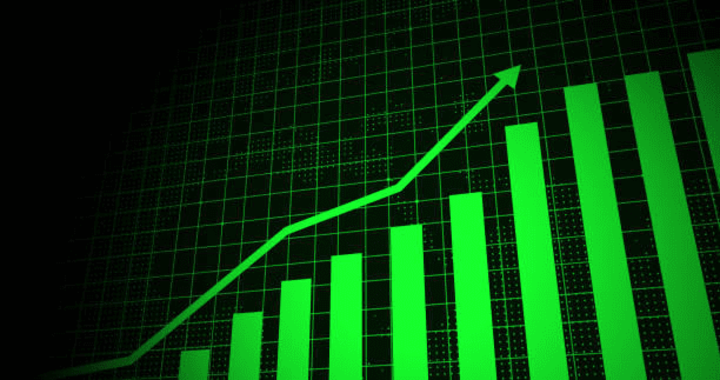
Credit: iStock
CME Group is a prominent player in the global derivatives market. As such, there are several key factors that can drive CME stock price. Some of these factors include the following:
- Trading Volumes: As a derivatives exchange, the majority of CME's revenue comes from transaction fees, which are tied to trading volumes. For example, if geopolitical tensions escalate and cause market uncertainty, trading volumes on CME's platforms may increase as investors rush to hedge their risks. This increased activity could increase CME's revenues and potentially CME stock price.
- Introduction of New Products: The announcement and successful launch of new trading products can have a positive impact on CME stock prices. For example, when CME Group announced the launch of bitcoin futures in 2017, it marked its entry into a new market. The resulting increase in trading volume contributed to an increase in CME stock price.
- Overall Market Conditions: CME stock price is also influenced by the overall health of the financial markets. During periods of economic growth and stability, trading volumes can increase as more entities look to engage in futures and options trading, which could positively impact CME stock price. Conversely, during periods of market downturns or recessions, trading volumes might decrease, which could adversely affect the stock price.
CME Stock Price Forecast
The consensus analysts' recommendations for CME stock is a strong buy. Sixteen financial analysts have provided their 12-month price predictions for CME stock. The median estimate of $210.00 suggests a potential upside of 12.81% from the current price of $186.16. The bullish high target is $250.00, and the low projection of CME stock is $155.00.
Challenges and Opportunities
CME Group, being a dominant player in the world of finance, faces competitive risks from other marketplaces like Nasdaq Inc, London Stock Exchange Group (LSEG), Euronext N.V., and Intercontinental Exchange (ICE). Positive developments for any of these competitors could potentially impact CME stock price.
For example, as a financial exchange, CME and its competitors constantly compete for market share. Both Nasdaq and LSEG have a strong global presence and a wide range of products and services. They offer securities trading and other financial services, such as data products, market technology, and listing services, which can attract many clients. This could potentially affect CME stock price.
That said, CME does have some competitive advantages. Some of these include the following:
- Global Reach and Diverse Portfolio: CME Group operates exchanges that offer the widest range of global benchmark products across all major asset classes, including futures and options based on interest rates, equity indices, foreign exchange, energy, agricultural commodities, metals, weather and real estate.
- Operational Efficiency: CME's electronic trading platform, Globex, is one of the world's fastest and most efficient electronic trading systems. Globex operates nearly 24 hours a day, allowing for high trading volumes and liquidity, which are key considerations for traders.
- Innovation and Technology: CME Group continually invests in technology to improve the speed, capacity, and reliability of its trading and clearing platforms. This includes implementing machine learning, blockchain technology, and other advanced technologies to stay ahead of the curve.
Other Risks
Other risks that could affect CME stock price include the following:
- Regulatory Risks: CME operates in a highly regulated industry. Changes in laws, regulations, or standards related to the financial sector can impact the company's operations, profits, and overall market dynamics. For example, new requirements for derivatives or a change in capital requirements can alter trading volumes and affect CME stock and revenues.
- Market Volatility: The exchange industry is closely tied to the overall health of the economy and the financial markets. Economic downturns, recessions, or periods of low market volatility can lead to decreased trading volumes and thus negatively impact CME stock and profitability.
- Technological Risks: In today's digital age, cybersecurity is a significant concern for all businesses, particularly for financial exchanges like CME that handle vast amounts of sensitive financial data. A major security breach could harm the company's reputation and operations, and potentially decreasing CME stock price.
Growth Opportunities

Credit: iStock
- Expanding Product Offerings: CME Group can leverage its position as a leading derivatives marketplace to introduce new products that cater to emerging market needs. For example, the introduction of Bitcoin futures and options in recent years has addressed the growing demand for regulated cryptocurrency trading instruments.
- Technological Innovation: CME Group's continuous investment in technology and innovation could significantly drive future growth. With the rise of financial technology (fintech), blockchain, and artificial intelligence, there are ample opportunities to streamline operations, improve trading experiences, and launch new products and services.
- Geographic Expansion:There are opportunities for growth in developing markets, especially in Asia and Africa, where financial markets are growing rapidly. Establishing partnerships, collaborations, or even new exchanges in these regions could drive increased volumes and revenue growth.
Future Outlook and Expansion
CME Group is well-positioned for future growth, given its scale, diverse product offerings, and robust technological infrastructure. For example, given the increasing acceptance of cryptocurrencies, CME Group might look to expand its offerings in this area beyond Bitcoin and Ether futures. Also, as financial markets become more global, CME Group might look to further expand its international footprint.
Why Traders Should Consider CME Stock
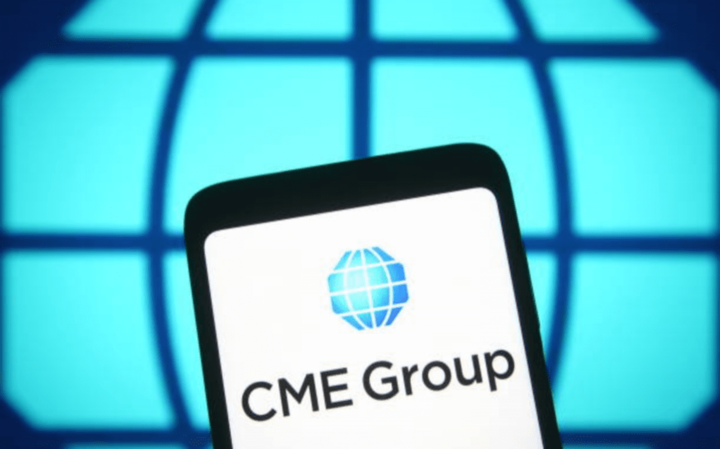
Credit: GettyImages
Are you currently considering trading CME stock? If you are, or you’re trying to decide if CME stock is the right investment option for you, then here are some reasons why you should definitely consider CME stock as an investment opportunity:
- Market Leadership: CME Group offers various products ranging from futures and options to swaps. This, in turn, attracts a high volume of traders, providing strong and consistent revenues.
- Innovation and Diversification: CME Group has demonstrated its ability to innovate and diversify its product offerings. This shows its ability to adapt and thrive in a changing market environment, an attractive feature for investors.
- Strong Financial Performance: The company has delivered consistent financial performance with steady revenue growth and strong profitability, which makes CME stock an attractive option for investors seeking stable returns.
- Global Expansion and Growth Opportunities: With expansion into international markets and the continuous development of new product offerings, CME Group offers growth potential, which could increase CME stock value over time.
Trading Strategies for CME Stock
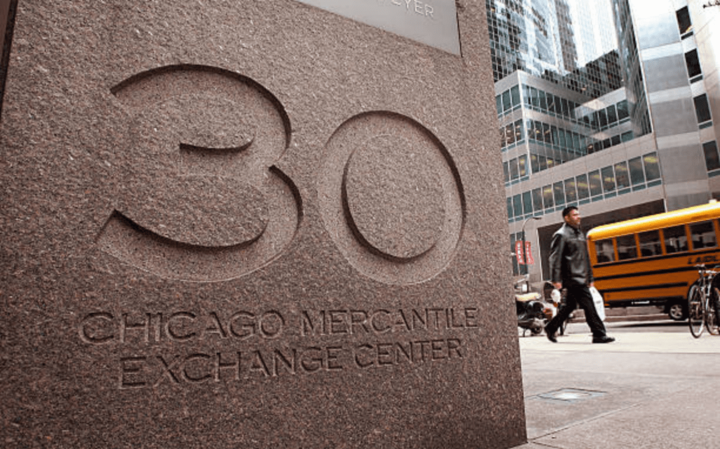
Credit: GettyImages
There are several trading strategies you can employ for trading CME stock to guarantee consistent profitability and returns. Here are some CME stock trading strategy recommendations for you:
- Buy-and-Hold Strategy: A buy-and-hold strategy for CME stock could be suitable for long-term investors. This strategy involves buying CME stock and holding it for an extended period, typically years or decades. The aim is to capitalize on potential price appreciation and dividend income over the long term.
- Fundamental Analysis: Fundamental analysis involves evaluating a company's intrinsic value by examining related economic, financial, and other qualitative and quantitative factors. For CME Group, this might include analysis of financial statements (including revenue, earnings, future growth, return on equity, and profit margins), as well as broader industry trends and market conditions.
- Moving Average Convergence Divergence (MACD): MACD is a trend-following momentum indicator that shows the relationship between two moving averages of a security's price. Traders might buy the CME stock when the MACD crosses above its signal line and sell the stock when the MACD crosses below the signal line.
For example, from the chart below, we can see that when the MACD line crosses above the signal line, it signals the start of a bullish movement. Conversely, a cross of the MACD line below the signal line indicates a potential bearish trend.
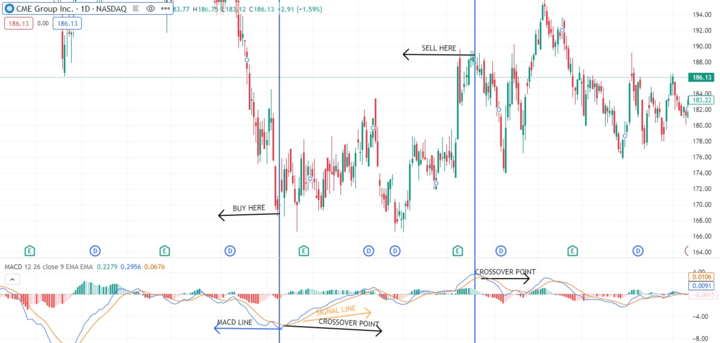
Ready to start trading CME stock but don't know how to? If so, then CFDs are the way to go! Why CFDs? Read on to find out.
Advantages of CFD
- Leverage: CFD trading allows for leverage, meaning you can gain exposure to a large position without committing the full cost up front. This can potentially amplify profits if the market moves in your favor. However, it can also amplify losses if the market moves against you.
- Short Selling:CFDs allow for short selling, which means you can profit from falling prices as well as rising prices. This is an advantage over traditional stock investing, where you typically profit only from price increases.
- Access to Global Markets: CFDs can be based on a wide variety of financial instruments, including stocks, commodities, indices, and forex pairs from around the world. This allows traders to diversify their portfolios and access markets that might otherwise be difficult or expensive to reach.
Trade CME Stock CFD with VSTAR
Looking for a CFD provider to trade CME stock? Look no further than VSTAR! VSTAR is an institutional-level trading platform that offers numerous advantages to traders and investors looking to take advantage of CFD trading. Some advantages of trading CME stock with VSTAR include the following:
- Deep Liquidity: VSTAR offers deep liquidity, ensuring orders can be filled quickly without significant price slippages. This will allow you to enter and exit trades at your desired price levels.
- Fully Regulated: VSTAR operates under strict regulatory guidelines designed to protect investors, providing transparency, accountability, and adherence to best practices in the financial markets.
- Lightning-Fast Execution: VSTAR's lightning-fast execution means that trades are processed in the blink of an eye. This will help you capitalize on market opportunities without delay, which can potentially increase the effectiveness of your strategies and overall profitability.
- 1000+ Instruments: With access to over 1000 trading instruments, VSTAR offers a broad range of investment opportunities. This will allow you to diversify your portfolio across various asset classes such as stocks, forex, commodities, indices, and more, thus spreading risk and potentially increasing returns.
Conclusion
CME stock appears to be poised for a significant bullish move, making it a perfect investment opportunity for traders and investors alike. In addition, the general analysts’ consensus of CME stock being a strong buy only further adds to the positivity surrounding CME stock. Download VSTAR today and position yourself to make the most of CME stock.
FAQs
1. What does CME mean for stocks?
CME stands for Chicago Mercantile Exchange. It operates a large marketplace for derivatives trading, including futures and options.
2. Is CME Group a buy?
CME Group (the parent company of CME) is generally seen as a good long-term investment by analysts due to its dominant market position and recurring transaction fees revenue model.
3. What does CME company do?
CME Group operates exchanges for derivatives trading and clearing as well as provides data services and risk management tools to derivatives market participants. Key products are interest rate, equity index, energy, and commodity futures & options.
4. What is the target price for CME stock?
The consensus 12-month analyst price target for CME stock is currently around $225. Individual analyst price targets range from $200 to $260.
